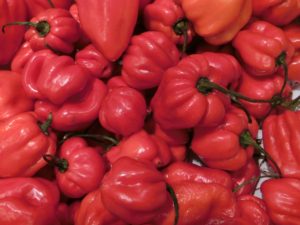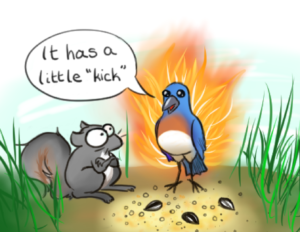My labmate was having a problem one morning – a fuzzy, gluttonous problem. To help keep her indoor cat entertained during her time at work, she thought it was a great idea to set up a bird feeder. Being so close to the woods, surely this would bring all of the birds to the yard. Unfortunately, the local squirrels soon flocked to the free food source like a group of grad students and left not one seed for their colorful avian counterparts. My advice to her? Grab the hot sauce!

Making the bird feeder a literal hot spot by sprinkling high-Scoville sauces on seeds is not meant to suggest that birds engage in the same machismo food challenges as humans. They simply are not irritated by the chemical in peppers that is “hot” to humans and other mammals: capsaicin.
There are biological differences between certain pain perception receptors in birds and mammals. The TRPV1 (transient receptor potential vanilloid subfamily, member 1) receptor, also known as the capsaicin receptor, is involved in the perception of unpleasant or harmful chemical, physical, and thermal stimuli. The molecular sequence of this receptor between birds and mammals is only 68% similar, as compared to the >95% similarity for most other central nervous system receptors. What this translates to is an unusually high avian threshold for tolerating the spice in hot peppers. While mammals are put off by concentrations of 10-100 ppm (up to about the heat level of a jalapeño pepper), birds are not even fazed by capsaicin levels >20,000 ppm (habanero pepper territory).

Chili peppers take advantage of this natural disparity in receptor sensitivity, according to the directed deterrence hypothesis, which states that fruits produce noxious or toxic chemicals that make them more appealing to organisms that will disperse their seeds and less appealing to those that would destroy the seeds. This is especially handy because the regions in which hot peppers grow (for example, throughout Central and South America) are favorable places for seed-eating rodents to thrive. It is common knowledge to chefs and laymen alike that the seeds of chili peppers are much hotter than the surrounding fruit, which serves as extra insurance against seed destruction by mammals that may be more desensitized to capsaicin than the average bear, so to speak.
While sprinkling hot sauce on your bird feed or suet cakes stands a good chance at repelling squirrels, anybody with That One Friend Who Puts Sriracha on Everything can tell you that a taste for spicy food can be acquired easily enough. Indeed, while the initial sensitivity to capsaicin differs from individual to individual, mammals can become desensitized to the unpleasant sensations associated with TRPV1 receptor activation, and can actually develop a preference for pungency.
Becoming acclimated to capsaicin via desensitizing TRPV1 receptors can open up a new world of chili pepper-related culinary possibilities, but quieting these receptors can have other effects. These receptors are activated by higher temperatures, and studies have shown that capsaicin-desensitized animals have impaired body temperature-regulating behaviors, which can make them more prone to accidental overheating. Because these receptors also convey information regarding painful physical or chemical stimuli, exposure to capsaicin has been used to better understand different types of pain in both rodents and humans alike.
So as we go from summer into what Chapel Hill calls “winter,” and if you feel like feeding the birds instead of the squirrels, there are a number of spicy bird foods available or you could make your own. (For those of you interested in feeding squirrels exclusively, birds are repelled by the compound methyl anthranilate, which is strangely enough a component of artificial grape flavoring.) Just keep in mind that the bolder squirrels might end up taking a liking to the spicy birdseed, but you can probably identify them easily enough by the little bottles of Sriracha that they will bring.
Peer edited by Amanda Tapia.
Follow us on social media and never miss an article:
Interesting! I have 2 birds and I never knew they could safely eat hot peppers. I’ve always guarded them but now I will let them enjoy a new treat. Thank you for the information.
Thanks for this. The ripe habanero peppers in my garden have been vandalized… upon closer examination I discerned a number of triangular beak holes. Now I know what’s going on!
Hi,
Very good article, and my first hit on google whilst searching for this very answer. However you have an error I’m afraid. The seeds of chilli fruit have absolutely no capsaicin in them at all. It’s the pith that holds the greatest concentration. Obviously being so close to the pith, the capsaicin will leach onto the seeds somewhat, but in scraping out the seeds, one generally catches the pith on the way. Hence lessening the effect.